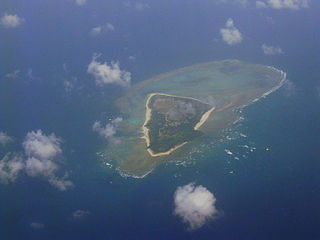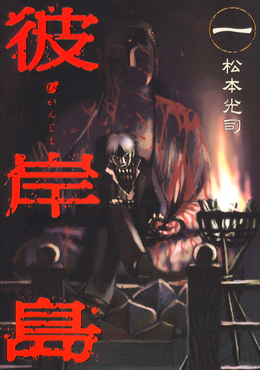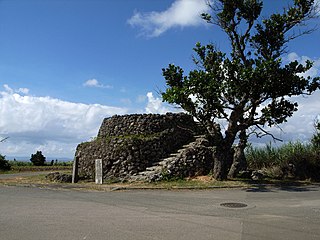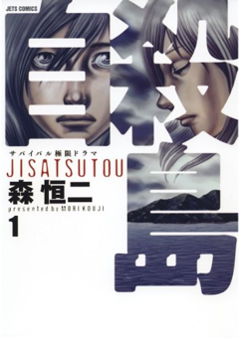List
![]() claimed but not controlled.
claimed but not controlled.
Japan has 14,125 [1] islands, approximately 430 islands are inhabited. [2] [3] This list provides basic geographical data of the most prominent islands belonging to, or claimed by, Japan.
![]() claimed but not controlled.
claimed but not controlled.

Kyūshū is the third-largest island of Japan's four main islands and the most southerly of the four largest islands. In the past, it has been known as Kyūkoku, Chinzei and Tsukushi-no-shima. The historical regional name Saikaidō referred to Kyushu and its surrounding islands. Kyushu has a land area of 36,782 square kilometres (14,202 sq mi) and a population of 14,311,224 in 2018.

Iwo Jima, officially romanized and pronounced Iōtō, is one of the Japanese Volcano Islands, which lie south of the Bonin Islands and together with them make up the Ogasawara Archipelago. Together with the Izu Islands, they make up Japan's Nanpō Islands. Although 1,200 km (750 mi) south of Tokyo on Honshu, Iwo Jima is administered as part of the Ogasawara Subprefecture of the Tokyo Metropolitan Government.

The Japanese archipelago is an archipelago of 14,125 islands that form the country of Japan. It extends over 3,000 km (1,900 mi) from the Sea of Okhotsk in the northeast to the East China and Philippine seas in the southwest along the Pacific coast of the Eurasian continent, and consists of three island arcs from north to south: the Northeastern Japan Arc, the Southwestern Japan Arc, and the Ryukyu Island Arc. The Daitō Islands, the Izu–Bonin–Mariana Arc, the Kuril Islands, and the Nanpō Islands neighbor the archipelago.

Reina Tanaka is a Japanese singer and musical actress. She is the leader of the Japanese rock band Lovendor. From 2002 to 2013, she was one of the main vocalists of the girl group Morning Musume and participated in other music acts under the Hello! Project name.

Hashima Island, commonly called Gunkanjima, is a tiny abandoned island off Nagasaki, lying about 15 kilometres from the centre of the city. It is one of 505 uninhabited islands in Nagasaki Prefecture. The island's most notable features are its abandoned concrete buildings, undisturbed except by nature, and the surrounding seawall. While the island is a symbol of the rapid industrialization of Japan, it is also a reminder of Japanese war crimes as a site of forced labour prior to and during World War II.

The Daitō Islands are an archipelago consisting of three isolated coral islands, administered by Japan, in the Philippine Sea southeast of Okinawa. The islands have a total area of 44.427 square kilometers (17.153 sq mi) and a population of 2,107.

The Ryukyu Islands, also known as the Nansei Islands or the Ryukyu Arc, are a chain of Japanese islands that stretch southwest from Kyushu to Taiwan: the Ryukyu Islands are divided into the Satsunan Islands and Okinawa Prefecture. The larger ones are mostly volcanic islands and the smaller mostly coral. The largest is Okinawa Island.

Minna Island, or Minnajima (水納島), is an island in the Miyako Islands in the jurisdiction of Tarama, Miyako District, Okinawa Prefecture, Japan.

Record of Lodoss War is a franchise of fantasy novels by Ryo Mizuno based on the work he originally created for a world called Forcelia as a rules-free setting for role-playing games (RPGs). There have since been multiple manga, anime and video game adaptations, several of which have been translated into English. The plots generally follow the conventions and structure of the RPG systems including Dungeons & Dragons and Sword World RPG, in which several characters of distinct types undertake a specific quest.

The sixth season of the One Piece anime series, split into two "Sky Island" chapters, was produced by Toei Animation, and directed by Konosuke Uda based on Eiichiro Oda's manga by the same name. It was licensed by Funimation as the first season after 4Kids Entertainment dropped their heavily edited dubbing. The sixth season deals primarily with the Straw Hat Pirates's exploration of the legendary Skypiea, a land of winged humanoids built upon clouds, where they face off against Eneru and his henchmen.

The Liancourt Rocks dispute, also called the Dokdo dispute or the Takeshima dispute, is a territorial dispute between South Korea and Japan regarding sovereignty over the Liancourt Rocks, a group of small islets in the Sea of Japan. The rocks are also known in Korea as Dokdo and in Japan as Takeshima. North Korea also claims sovereignty of the islands, but has not pursued its claim to the same extent as the others.

Ishigaki is a city in Okinawa Prefecture, Japan. It includes Ishigaki island and the Senkaku Islands territory. The city is the political, cultural, and economic center of the Yaeyama Islands. New Ishigaki Airport serves the city. As of December 2012, the city has an estimated population of 48,816 and a population density of 213 persons per km2. The total area is 229.00 km2.

Higanjima is a Japanese manga series written and illustrated by Kōji Matsumoto. It was serialized in Kodansha's seinen manga magazine Weekly Young Magazine from 2002 to 2010, with its chapters collected in 33 tankōbon volumes. A second series, Higanjima: Saigo no 47 Nichikan, was serialized in the same magazine from 2010 to 2014; a third series, Higanjima 48 Nichigo… started in 2014.

The Sakishima Beacons are a network of eighteen observation platforms and beacons dating to the early Edo period and located in the Sakishima Islands, Okinawa Prefecture, Japan. Erected in 1644 by the government of the Ryūkyū Kingdom at the instigation of the Satsuma overlords, at a time of international tension during the transition between the Ming and the Qing Dynasties of China, the beacons were responsible for monitoring and reporting on maritime traffic, with a view to restricting foreign vessels in accordance with the Tokugawa policy of sakoku, i.e. national seclusion. After an initial survey by the Council for the Protection of Cultural Properties in 1993, due to uncertainties over land rights and difficulties of coordination between the involved municipalities, it was not until 2007 that they were jointly designated an Historic Site.

The E001 series (E001形), branded Train Suite Shiki-shima is a hybrid electric/diesel deluxe sleeping-car excursion train operated by the East Japan Railway Company since 1 May 2017. The Train Suite Shiki-shima is one of the world's most exclusive and expensive trains.

Irabu Island, is an island in Miyakojima, Okinawa Prefecture, Japan. The island is connected to Miyako Island by a 3,540-metre-long (11,610 ft) bridge Irabu Ohashi (伊良部大橋), which was completed in January 2015. Irabu Island is also connected via six bridges to Shimoji-shima. There are multiple language variants spoken on the island: Nakachi-Irabu, Kuninaka, Sawada-Nagahama, and Sarahama.

Jisatsutō is a Japanese manga series written and illustrated by Kouji Mori. It was serialized in Hakusensha's seinen manga magazine Young Animal from November 2008 to August 2016, with its chapters collected in seventeen tankōbon volumes. A prequel series, titled Muhōtō, was serialized in the same magazine from February 2019 to July 2022, with its chapters collected in six tankōbon volumes.

Island in a Puddle is a Japanese manga series written and illustrated by Kei Sanbe. It was serialized in Kodansha's seinen manga magazine Evening from November 2019 to September 2021. The story is about a boy who switches bodies with a wanted criminal.